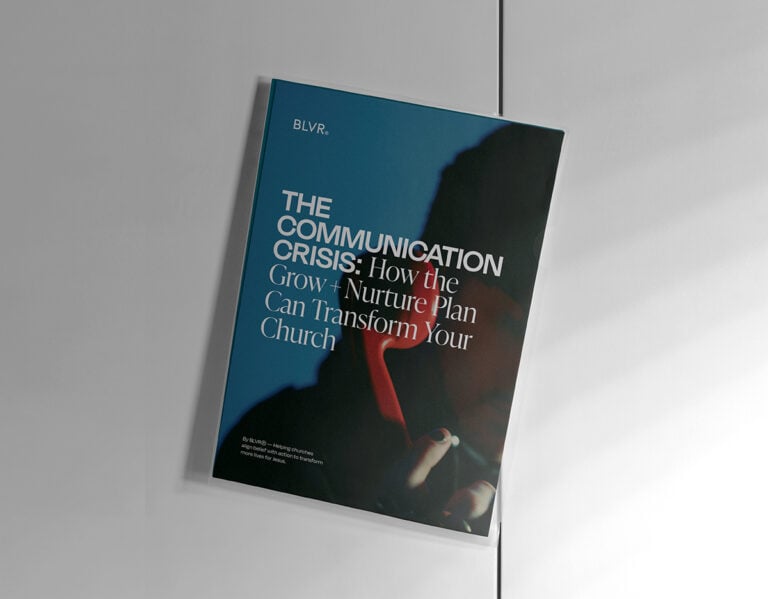
Church Branding / BY Adam Mcwethy
Stop Relying on Sunday: Why Your Church’s Email Strategy Is Failing Your Congregation
Published On 04.21.2025
Article
The Discipleship Opportunity You’re Missing Every Week
I have been working with my church in east county San Diego for several months now to begin nurturing our contact list with intentionality. Every week we’ve been sending out a personalized email to each of our audience groups (i.e. Men, Women, Youth, etc). These emails include a personal message from the pastor, a Sunday recap with a link to watch the message, and a promo for the Wednesday night Bible study. After just two months of consistently sending these basic nurture emails, our church has seen deeper relationships, church wide growth, and actual discipleship happening beyond Sunday mornings.
If it can work for my church, it can absolutely work for yours.
Here’s the painful reality many lead pastors are facing today: You’re relying heavily on your Sunday message to nurture your congregation. One hour, once a week. That’s it. Meanwhile, you’re missing other opportunities to provide hope and help to your people during the other 167 hours of their week.
This Say-Do Gap is crippling your ministry impact. You say discipleship matters, but what are you doing about it Monday through Saturday?
The solution isn’t complicated, but it does require commitment: Develop and execute a plan to nurture the people on your contact list consistently throughout the week.
When this Say-Do Gap closes, something remarkable happens: The people you’re called to shepherd actually begin moving through the nurture funnel and progressing in their spiritual formation. They grow. They mature. They become disciple-makers themselves.
Here’s the key takeaway that could transform your ministry: Using email to nurture your contact list is one of the most effective ways to deepen relationships, build trust, and move people along in their spiritual formation. It’s not just data management—it’s discipleship.
“Therefore encourage one another and build one another up, just as you are doing.”
— 1 Thessalonians 5:11
What True Nurturing Actually Means
Let’s get clear about what we mean by “nurturing.” We’re talking about helping people take their next step in Jesus through spiritual formation. Nurture is about engaging your community, staying top of mind, being consistent, being relevant and helpful, and providing genuine hope.
The primary goals of nurturing are twofold:
- Discipleship — moving people along their path of spiritual formation; from lost to found, and from found to following.
- Evangelism — getting your people to a place where their hearts ache for the lost, for those who will spend eternity separated from God
As church pastors and leaders, you are called to disciple your flock. But unfortunately, too many pastors rely on a single Sunday message to accomplish this massive biblical mandate. One shot per week.
You’re missing a huge opportunity to nurture your people throughout the week via email. With minimal additional effort, you can transform your cornerstone Sunday message into bite-sized “cobblestone” pieces of content to share with your audience throughout the week. These smaller content pieces—whether written, video, or audio blog posts—can reinforce your message and provide practical application when shared via email.
While there are multiple channels for nurturing your audience, email remains the most accessible and effective for most churches. It’s time to take it seriously.
The Untapped Power of Nurturing Through Email
Let’s face facts: Email continues to be the #1 most cost-effective way to reach your addressable audience. Period. No other communication channel gives you such direct access to your congregation’s attention at such minimal cost.
Email allows you to minister to both the masses and the one lost sheep. You can communicate with hundreds or thousands at once, while still creating personalized experiences that make individuals feel seen and valued.
But here’s where most churches get it catastrophically wrong: They blast the same generic message to everyone on their list. This approach is spiritually tone-deaf and practically ineffective.
Your emails should be crafted specifically for each audience segment. A message for men pursuing Godliness looks different from one for new parents navigating faith with young children. This targeted approach provides a relevant, engaging experience that actually resonates with recipients.
Want to dramatically improve your email effectiveness? Follow these proven strategies:
- Create subject lines focused on audience pain points—be provocative and generate curiosity
- Vary your email body copy styles and lengths; appearance matters, and too many identical-looking emails create disengagement
- Include clear calls to action that link to video messages, landing pages on your church website, or solicit direct responses
- Maintain absolute consistency—one-off, sporadic emails are ineffective because they lack consistency and fail to build trust
Pick a specific day and time to send your audience group emails every week and stick to it religiously. Consistent communication reinforces your church’s identity, demonstrates reliability, and nurtures ongoing engagement.
Track your effectiveness with statistics like open rates, click-through rates, and unsubscribes. How do your emails compare to the industry average open rate of 30.59% or the average click-through rate of 7.22%? You can’t improve what you don’t measure.
For churches ready to take their nurture strategy to the next level, email automation represents a massive opportunity most ministries completely overlook. Automated email sequences can save time, reduce costs, ensure consistency, and dramatically improve quality control. Consider implementing automation for:
- Follow-up sequences for first-time visitors
- Event registration confirmations and reminders
- New believer discipleship pathways
- Volunteer onboarding and training
- Pre-campaign buildup and post-event follow-through
An effective nurture strategy revolves around thoughtfully designed email sequences that are campaign-based (structured around a monthly or quarterly focus) and automated (delivered at consistent intervals). This approach ensures reliable communication that moves people along the engagement funnel without overwhelming your staff.
Stop Making Excuses and Start Nurturing
It’s time to get off the sidelines and take action. Here’s your roadmap to implementation:
Level #1 – Start With the Basics
Send a weekly email to each of your audience groups (Men, Women, Youth, etc.) sharing a Sunday recap with a link to watch the message. Add a personal note from the pastor that further disciples the recipients. Use this email to promote mid-week activities that encourage participation. After establishing a steady rhythm with these once-weekly emails, advance to the next level.
Level #2 – Layer in Resource-Based Campaigns
People in your community are lost and hurting. Your church is uniquely positioned to provide the specific hope and help they desperately need. Create a campaign for each audience group that includes one substantial cornerstone content piece (like an eBook guide) supported by three bite-sized cobblestone pieces of content derived from it. House these resources as blog posts on your church website and share them through weekly nurture emails.
Level #3 – Grow Through Automated Sequencing
Repurpose your nurture emails from Level #2 into a “longtail” nurture sequence. Run targeted digital ad campaigns within your local community that drive people to gated content landing pages. When they enter their email address to access your cornerstone content, they’re automatically enrolled in your nurture sequence, receiving regular spiritual guidance while building a relationship with your church.
Your Discipleship Mandate Extends Beyond Sunday
Using email to nurture your contact list isn’t optional in today’s ministry context—it’s essential. It’s one of the most effective tools for deepening relationships, building trust, and moving people along in their spiritual formation.
Be honest with yourself: Do you currently send at least one dedicated email to each of your various audience groups every single week? If not, you’re leaving discipleship opportunities on the table.
Churches that implement consistent email nurturing see tangible results. Engagement increases. Attendance stabilizes. Giving grows. Most importantly, people actually progress in their faith journey instead of remaining spiritual infants year after year.
The apostle Paul didn’t disciple the early church with a single weekly teaching. He wrote letters. He sent messengers. He maintained ongoing communication to “encourage and build up” the believers.
In today’s digital age, email is your epistle. Use it wisely, use it consistently, and watch your ministry impact multiply beyond the walls of your sanctuary and the hours of your Sunday service.
Your congregation is waiting in their inbox. What will you send them?
YOUR NEW COMMS PLAN
Learn how your church can apply an approach that businesses have used to successfully acquire new customers and retain existing customers. Use the power of audience segmentation to deliver personalized messages that are relevant to each person within you external and internal church community.

About the Author

Adam Mcwethy
Partner / COO
With almost 25 years of agency experience, Adam has worked with close to 500 brands, including Globe, World Vision, Marcus & Millichap, Creative Planning, and Liberty Station to name a few. Today Adam is focused on helping churches make a larger impact by attracting new guests and fostering deeper engagement from existing members. He is able to do this by bringing the insights he’s learned over the last two-decades of working with businesses to grow and retain their customers.
© BLVR
SD / CA




